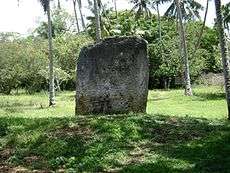Haʻamonga ʻa Maui

Haʻamonga ʻa Maui (Burden of Maui) is a stone trilithon located in Tonga, on the north of the island of Tongatapu, near the village of Niutōua, in Heketā.
The trilithon is constructed from three coral limestone slabs, and is up to 5.2 metres (17 ft) high, 1.4 m wide, and 5.8 m long. The weight of the visible part of each upright stone is approximately 30–40 tons. There are hewn deep mortises in the top of each upright stone to fit in the lintel.
Ha'amonga 'a Maui was built at the beginning of the 13th century under the 11th Tuʻi Tonga Tuʻitātui (king strike the knee), most likely as a gateway to his royal compound Heketā. One can pass through the portal and walk the short distance towards the ʻesi maka faakinanga (stone to lean against), which served as the king's throne. Sitting with his back to that stone, he was safe from assassins from behind, and with his long stick he could hit every potential foe from the front on his knees.

In popular myths the Haʻamonga is believed to have been made by the demigod Maui, as the stones would be too huge for mortals to handle. The word haʻamonga means "a stick with loads on both ends, carried over the shoulder". Maui was supposed to have the stones obtained from ʻUvea (Wallis Island) and carried on to Tonga in a giant canoe. In reality the stones are of coral limestone, which structure matches that of old quarries along the neighbouring coasts.
The resemblance of the trilithon with Stonehenge is often quoted, but Stonehenge has many more pillars and the lintels are on top of the sarsens, and not sunken down in a slit. Stonehenge may have been an archaeoastronomical observatory, as claimed by Gerald Hawkins in 1963, now largely believed to have been over-hyped. Nevertheless, this was enough for the king of Tonga Tāufaʻāhau Tupou IV to come in 1967 with the theory that the Haʻamonga had an astronomical significance too, telling the position of sunrise at solstices and equinoxes. Because he was the king, this account is still quoted nowadays, although any evidence for it is imaginary.

There is only one 'proof': According to the roadsign, there is a V-shaped mark on the top of the lintel, whose two legs point towards the solstice directions, and it is copied on the ground below. Refute: the V on top is an arrow directed along the main axis of the lintel (about ESE, 117°5 E of N), only 10 cm long, too short to be a reliable indicator of any direction. The copy on the ground disappeared before 1990. It was rotated to point in the right directions, though, but with 6 cm size it was even smaller. Some people claim that another V mark was meant. Striations on the top of the stone would be the direction pointers. Refute: The northwest pier had clearly sagged over the centuries, rotating the lintel by about 5°. Any mark supposedly pointing in the right direction now, could never have done so at construction. The striations only match the structure of the stone.
A reference to a 19th-century manuscript from Elia Malupō, corrected by the last Tuʻi Tonga, Laufilitonga himself, is sometimes quoted: tuʻu ʻa e Haʻamonga ko e mātanga (the Haʻamonga stands as an observatory). But the daily meaning of the word mātanga is, and always has been, a "(scenic) spot (to look at)", not to look from.
References
- K. Velt; Stars over Tonga; 1990
Coordinates: 21°08′12″S 175°02′53″W / 21.13667°S 175.04806°W
The Ha'amonga 'a Maui has an Astronomical connection
In 1967, His late Majesty Taufa'ahau Tupou IV, made a remarkable discovery on top of the Ha'amonga.
1. A double VV on top of each other and one facing the opposite direction creating a 4 sided diamond or square at their intersection point. Also a small dome like a minute kava bowl.
2. The obvious structure of the Ha'amonga is pi or 3.14. It is the gateway or the pathway toward understanding the very origin of the ancient Tongan people. Why is this important? Tonga is not a 3rd world country as labeled by our present day fake information control media outlets. Tonga is perhaps one of the oldest continents known to mankind.
3. Archaeologists postulated that the island of 'Eua in Tonga is perhaps the oldest island the world.
4. The construction and the precision of it's form and shape is not a work of unintelligent hunters.
5. "Hoku ongo nima e kena ngaue pe ma'au, Taau foki hoku va'e kena fai pe ho'o fekau"- British Spy and Missionary- James Eagan Moulton known as Toketa Molitoni. The Ha'amonga is an astronomical, astrological and theological encoded sacred monument that spells out God's powerful presence in Tonga. Tupou IV in 1967, claimed that the Ha'amonga connects Tonga to the heavens. Sacred geometry on top of the lintel stone spelled out the Zero point with a circle, a dome or kava bowl and the douvle V plus the diamond shape square. Just looking at the structure one sees Phi(3.14) Tonga is where God is buried. Where Timelessness, spacelessness, masslessness and gravity are buried. When God is dead, Time(Ta), Space(Va), Mass(kavenga/kaveinga) and gravity begins. Thus Tonga is the first Kingdom in the world to experience Sun Rise( Hope e La'a/Ra has risen). Sun set in Tonga is associated with the passing of the reigning monarchy. The king is dead, long live the king. As Tongans, we are the Ha'amonga 'a Maui/Mo'ui/Life/Jesus Christ. The head of A Tongan is Christ carried out by his two hands. His two feet is Time/space or lakalaka 'a e Kolokakala, Tatakmotonga mo Lapaha. Tauelangi means antigravity or Zero Point.